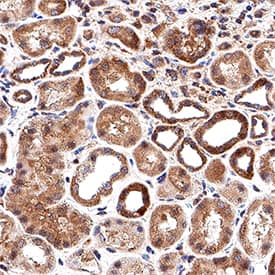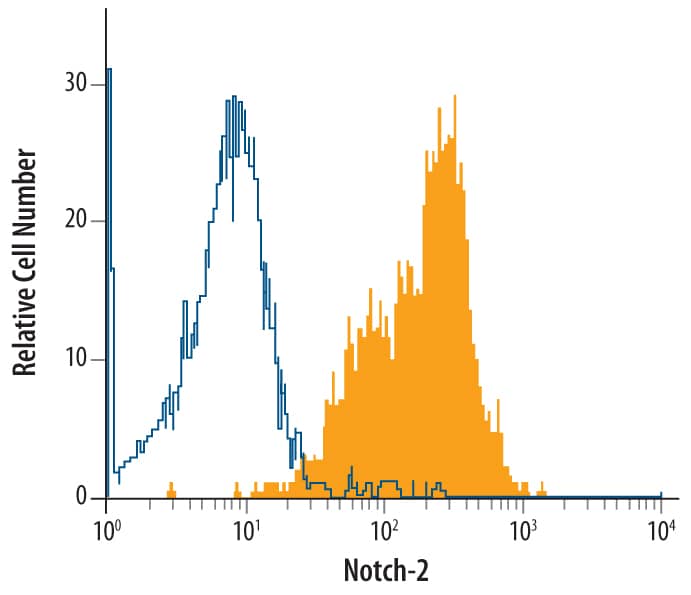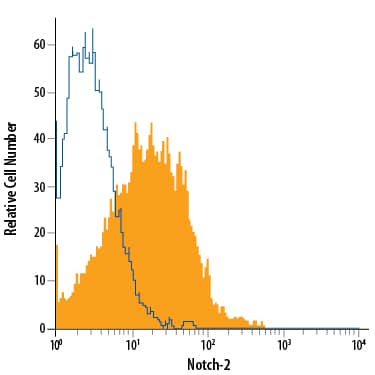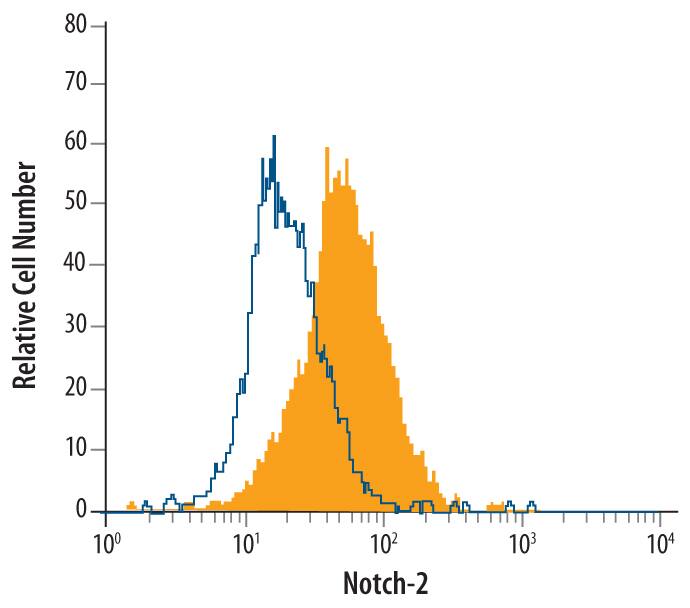Notch-2 Products
Notch proteins (so named for notches in fly wings) are type I transmembrane glycoproteins involved in specifying cell fates and defining boundaries between different cell types during developmental processes. Notch extracellular domains are large, having 34-36 EGF-like repeats followed by three notch/Lin-12 repeats. Notch proteins interact with transmembrane ligands Jagged, Delta, and Serrate expressed on the surface of a neighboring cell. Upon ligand binding, a series of cleavage events results in the release of the Notch intracellular domain (NICD), which translocates to the nucleus and initiates transcription of Notch-responsive genes. Thus, Notch acts as both a ligand-binding receptor and a nuclear factor that regulates transcription.
The four mammalian Notch receptors appear to have distinct functions, since they do not compensate for one another in genetic studies. Mutations in Notch receptors also lead to specific developmental disorders. For example, Notch-3 is predominantly expressed in the developing central nervous system of mice. Mutations in Notch-3 in humans cause an autosomal dominant condition called CADASIL (cerebral autosomal dominant arteriopathy with subcortical infarcts and leukoencephalopathy). This disorder is characterized by recurrent ischemic strokes at an early age without any underlying vascular risk and progressive dementia.
203 results for "Notch-2" in Products
203 results for "Notch-2" in Products
Notch-2 Products
Notch proteins (so named for notches in fly wings) are type I transmembrane glycoproteins involved in specifying cell fates and defining boundaries between different cell types during developmental processes. Notch extracellular domains are large, having 34-36 EGF-like repeats followed by three notch/Lin-12 repeats. Notch proteins interact with transmembrane ligands Jagged, Delta, and Serrate expressed on the surface of a neighboring cell. Upon ligand binding, a series of cleavage events results in the release of the Notch intracellular domain (NICD), which translocates to the nucleus and initiates transcription of Notch-responsive genes. Thus, Notch acts as both a ligand-binding receptor and a nuclear factor that regulates transcription.
The four mammalian Notch receptors appear to have distinct functions, since they do not compensate for one another in genetic studies. Mutations in Notch receptors also lead to specific developmental disorders. For example, Notch-3 is predominantly expressed in the developing central nervous system of mice. Mutations in Notch-3 in humans cause an autosomal dominant condition called CADASIL (cerebral autosomal dominant arteriopathy with subcortical infarcts and leukoencephalopathy). This disorder is characterized by recurrent ischemic strokes at an early age without any underlying vascular risk and progressive dementia.
| Reactivity: | Human |
| Details: | Goat IgG Polyclonal |
| Applications: | WB, IHC |
| Reactivity: | Rat |
| Details: | Goat IgG Polyclonal |
| Applications: | WB, Flow, IHC, Block, CyTOF-ready |
| Reactivity: | Rat |
| Details: | Goat IgG Polyclonal |
| Applications: | WB, Flow, IHC, Block, CyTOF-ready |
| Reactivity: | Human |
| Details: | Mouse IgG1 Monoclonal Clone #602845 |
| Applications: | Flow, CyTOF-ready |
| Reactivity: | Rat |
| Details: | Goat IgG Polyclonal |
| Applications: | WB, Flow, IHC, Block, CyTOF-ready |
| Reactivity: | Rat |
| Details: | Goat IgG Polyclonal |
| Applications: | WB, Flow, IHC, Block, CyTOF-ready |
| Reactivity: | Rat |
| Details: | Goat IgG Polyclonal |
| Applications: | WB, Flow, IHC, Block, CyTOF-ready |
| Reactivity: | Rat |
| Details: | Goat IgG Polyclonal |
| Applications: | WB, Flow, IHC, Block, CyTOF-ready |
| Reactivity: | Human |
| Details: | Rabbit Serum Polyclonal |
| Applications: | IHC, WB, ELISA |
| Reactivity: | Human |
| Details: | Rat IgG2a Monoclonal Clone #411801 |
| Applications: | WB |
| Reactivity: | Human |
| Details: | Goat IgG Polyclonal |
| Applications: | WB |
| Reactivity: | Rat |
| Details: | Goat IgG Polyclonal |
| Applications: | WB, Flow |
| Reactivity: | Human |
| Details: | Mouse IgG1 Monoclonal Clone #602845 |
| Applications: | Flow |
| Reactivity: | Mouse |
| Details: | Rat IgG1 Monoclonal Clone #605724 |
| Applications: | Flow, CyTOF-ready |
| Reactivity: | Rat |
| Details: | Mouse IgG1 Monoclonal Clone #199509 |
| Applications: | WB |
| Reactivity: | Human |
| Details: | Rabbit IgG Polyclonal |
| Applications: | WB |
| Reactivity: | Human |
| Details: | Rabbit IgG Polyclonal |
| Applications: | WB |
| Reactivity: | Rat |
| Details: | Goat IgG Polyclonal |
| Applications: | WB, Flow, IHC, Block, CyTOF-ready |
| Reactivity: | Rat |
| Details: | Goat IgG Polyclonal |
| Applications: | WB, Flow, IHC, Block, CyTOF-ready |
| Reactivity: | Rat |
| Details: | Goat IgG Polyclonal |
| Applications: | WB, Flow, IHC, Block, CyTOF-ready |
| Source: | CHO |
| Accession #: | Q04721 |
| Applications: | Bind |
| Reactivity: | Human |
| Details: | Rabbit IgG Polyclonal |
| Applications: | IHC, WB, IP |
| Reactivity: | Mouse |
| Details: | Rat IgG1 Monoclonal Clone #605724 |
| Applications: | Flow |
| Reactivity: | Human |
| Details: | Mouse IgG1 Monoclonal Clone #602845 |
| Applications: | Flow |
| Reactivity: | Human |
| Details: | Mouse IgG1 Monoclonal Clone #602845 |
| Applications: | Flow |





![Western Blot: Notch-2 Antibody [NB600-879] Western Blot: Notch-2 Antibody [NB600-879]](https://resources.bio-techne.com/images/products/Notch-2-Antibody-Western-Blot-NB600-879-img0005.jpg)


![Western Blot: Notch-2 Antibody [NBP2-27347] Western Blot: Notch-2 Antibody [NBP2-27347]](https://resources.bio-techne.com/images/products/Notch-2-Antibody-Western-Blot-NBP2-27347-img0002.jpg)
![Western Blot: Notch-2 AntibodyAzide and BSA Free [NBP2-77072] Western Blot: Notch-2 AntibodyAzide and BSA Free [NBP2-77072]](https://resources.bio-techne.com/images/products/Notch-2-Antibody---Azide-and-BSA-Free-Western-Blot-NBP2-77072-img0001.jpg)

![Western Blot: Notch-2 Antibody [NBP1-19125] Western Blot: Notch-2 Antibody [NBP1-19125]](https://resources.bio-techne.com/images/products/Notch-2-Antibody-Western-Blot-NBP1-19125-img0002.jpg)